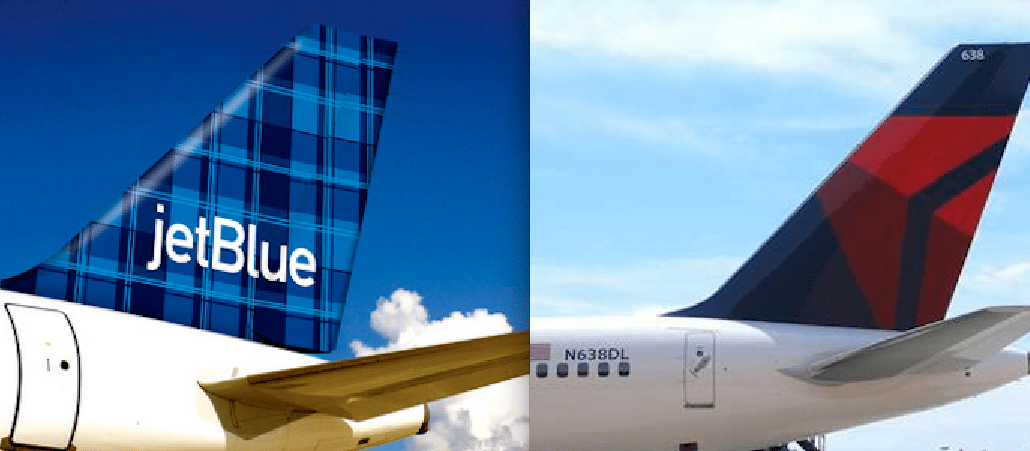
In this week’s battle of the brands, we look at two airline companies traveling in different directions: the old-timer Delta and the relatively new upstart JetBlue. Which airline travels the distance in the digital world?
Delta:
Facebook: Delta’s timeline photo is, in a word, America. An image of a freshly cut lawn, a baseball and baseball glove sit beside two Delta tickets and an iPhone. The photo hits the corporate image on the head, and Delta’s timeline doesn’t disappoint. The company was founded in 1924 for crop dusting, but in 1929, it took its first passengers. There are 312,000 likes on its page. Navigating the timeline, we learn about the company’s history through informative images. Links go to photos, events, contests, customer service, booking, locations, videos and a social traveler to connect with friends who also may be traveling. Posts are updated several times a week, with emphasis on Delta customer stories, like the couple who met on a Delta flight and now are getting married.
Twitter: Delta has 321,000 followers on Twitter. In its bio, Delta mentions it is listening. It tweets several times a day, linking to company contests as well as actively engaging with its audience. Plenty of @ replies here, mostly affirming people’s tweets to Delta, but also tweeting apologies when necessary. The company understands Twitter’s role in its brand communication.
YouTube: Delta has 130 videos, which have been viewed 7.7 million times, and 7,500 subscribers. Videos give a peek into Delta — company, staff and airplanes. There are Delta ads housed on YouTube, as well as videos with partners, such as its contest to send someone to travel to Major League ballparks.
Mobile site: Delta has a mobile side that gives you the information you need: flight status and updates. But it also gives advisories. It links to check-ins, schedules, baggage, bookings, deals and offers, travel information and planning tools.
Mobile app: The Delta iPhone app enables you to download your boarding pass, check in to flights, view, select, and change your seat, as well as get push notifications on flight status. You can also change your flight via the app, if need be, as well as pay for and track your bags. There’s also a cool flight tracker that allows you to map flights en route.
JetBlue:
Facebook: JetBlue, founded in 1999, walks users through the last 13 years via the Timeline. Since it’s only been a bit more than a decade since the first JetBlue flight, the company has plenty of digital memories to share. From photos to links to videos, the company tells its story on Facebook in an engaging way. It has 600,000 likes and links go to photos, videos, events, locations, TrueBlue (its rewards program) and the ability to create a vacation. Curiously, there’s no place to purchase tickets via Facebook (unless you’re a member of TrueBlue). Posts are pretty regular; several times a week, whoever runs the Facebook account will post deals or questions or polls or even information. JetBlue does a good job on its Facebook page asking, and getting, users to participate.
Twitter: There are 1.67 million followers of the airline’s Twitter feed. JetBlue is a tweeting machine, with a little more than 25,000 tweets under its belt. The feed is a one-stop shop for all things JetBlue. Just like other big brands, there’s a good amount of customer service (but as it says in its bio, the feed “doesn’t respond to formal complaints on Twitter,” but there are plenty of @ replies to people tweeting to the company. There are few, if any, non @ reply tweets. The brand clearly uses Twitter as a conversation-mechanism.
YouTube: JetBlue has 30 videos with 1.6 million views. There are 1,200 subscribers. The videos are posted infrequently (the most recent was from three months ago). Videos on the channel include some of its better commercials, travel videos and even footage from artists who perform at the company’s terminal in JFK, Terminal 5.
Mobile site: JetBlue has a mobile-optimized site that lets you check your flight status, check in, get travel alerts and even book a flight. There are links that let you find flight deals, look at TrueBlue rewards and check out the inflight experience.
Mobile App: The JetBlue iPhone app lets you do all the same things as the website, but it also lets you look at the DirecTV channel guide, connect to friends and share travel plans. It also provides flight updates with push notifications within the app.
Conclusion:
Social: Delta is using Facebook, Twitter and YouTube in effective ways to highlight its brand and to engage its customers. Its Travelist contest is intertwined on Facebook, YouTube and Twitter: a grand-slam strategy. JetBlue is doing a great job in communicating its brand to consumers through its social networks. As you can see, both airlines understand how social media should work, but Delta gets the victory today due to its multi-networking strategies and branding.
Mobile: Again, both companies understand what information people are looking for when using mobile devices. Each airline’s mobile and iPhone app are similar, but the social sharing on JetBlue gives it the slight edge today.
More in Marketing

After watching X’s ownership issues play out, marketers brace for TikTok whiplash in 2026
TikTok’s ownership drama has echoes of X (formerly Twitter), but ad performance has kept marketers for fleeing—for now.

‘There’s no room for purists’: Generative AI is altering the agency junior talent search
AI is altering agency business models. It’s altering the skills they’re hiring for and where they’re hiring them from, too.

For platforms, here’s what’s not going to happen in 2026
Rather than the traditional platform predictions, this is a list of what Digiday believes won’t happen next year.





